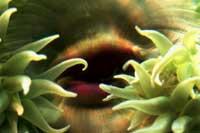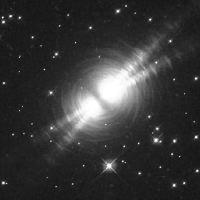Man, alien?
2001/02/04 Carton Virto, Eider - Elhuyar Zientzia
A few days ago NASA released an experiment of great impact. The harsh spatial conditions were reproduced in the laboratory and radiated several simple molecules with ultraviolet light. The result was surprising: they discovered the formation of complex molecules in membrane structures. This has recovered the theory of the extraterrestrial origin of life.
But what exactly have NASA researchers achieved? Conventional molecules such as water, carbon dioxide, carbon monoxide and methanol have been placed at very low temperatures at -26ºC. In this situation they have been given strong ultraviolet light radiation, reproducing somehow the conditions in which the solar system was created.
The researchers expected the process to generate complex molecules, but in no case did they foresee the actual result. Very complex organic molecules were formed in the experiment and, mixed with water, they were organized into membrane structures. In fact, these structures are very similar to molecules that were supposedly critical at the origin of life.
Bricks of Life
Membrane structures are essential in biological processes. They participate in reactions, transport of compounds and other processes. All known biological systems use membranes to produce and capture energy from cells. Therefore, it is considered that they played an important role in the origin of life.
Experiments by NASA researchers have shown that complex organic structures can arise in difficult spatial conditions. These simple molecules are found in space and ultraviolet radiation too. Therefore, the reactions made in the laboratory are very possible in all corners of the space.
Does all this mean that life comes from space? Not necessarily. NASA researchers have made no such claims. They have only shown that many structures that have been attributed to the creation of life a fundamental role can arise in space. These structures may have come from space in Earth's youth and may act as support for the development of life. But they are just beliefs. Because talking about the origin of life is talking about theories, convictions and hypotheses.
Conventional theory

The theory of greater current acceptance is based on the ideas of the Russian chemist and biologist Oparin. Oparin published in 1924 the theory that the chemical compounds of the primitive atmosphere are the origin of life. According to this theory, the first organic molecules were formed from simple molecules present in the atmosphere. Unlike what happens now, the atmosphere was very rich in methane, ammonia, hydrogen, carbon dioxide... and they were the origin of life. Under violent temperatures and radiation, they became complex organic molecules, accumulated in the oceans and in 3,000 years the first cells appeared. The exact way this happened has not yet been possible, but it is almost certain that life began in the oceans, except for strong solar radiation. In the 1950s, Stanley Miller tried to demonstrate Oparin's theory and discovered that from the Gas Mixture, similar to the primitive atmosphere, amino acids and nucleotides were formed. That is, basic components of protein and DNA. In short, life is due to random chemical reactions that occurred billions of years ago in the Earth's oceans.
In the 1970s, however, the theory that life had not occurred in the oceans, but in space, began strongly. Panspermia's theory argues that the first cells were due to chemical reactions, but occurred in space. Later, they arrived on Earth in meteorites or otherwise, finding conditions to develop here. The Greek philosopher Panspermia Anaxagoras was the first to quote. Anaxagoras spoke of the germinates distributed through space to explain the origin of life. His theory has had several defenders throughout history and, as has been said, has been the XX. In the 70s of the 20th century they began to take serious force.
NASA's discoveries may give new inspiration to the theory of Panspermia, even though NASA researchers have claimed it does not allow so much. They suggest that more complex molecules and structures can be found in space than expected, but it is still too early to predict anything else.
Published in the newspaper

Gai honi buruzko eduki gehiago
Elhuyarrek garatutako teknologia






